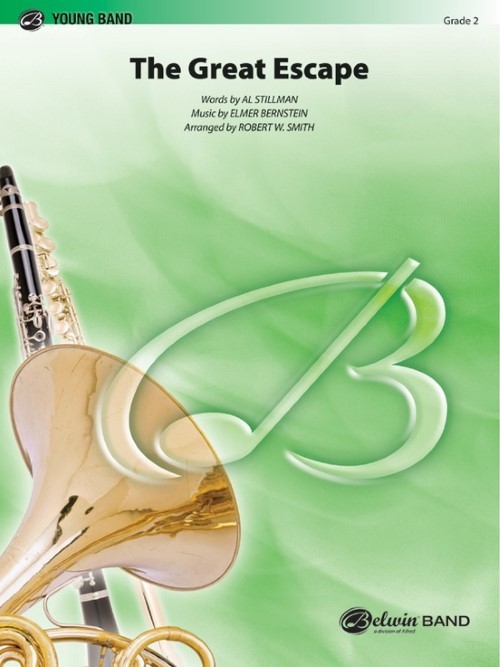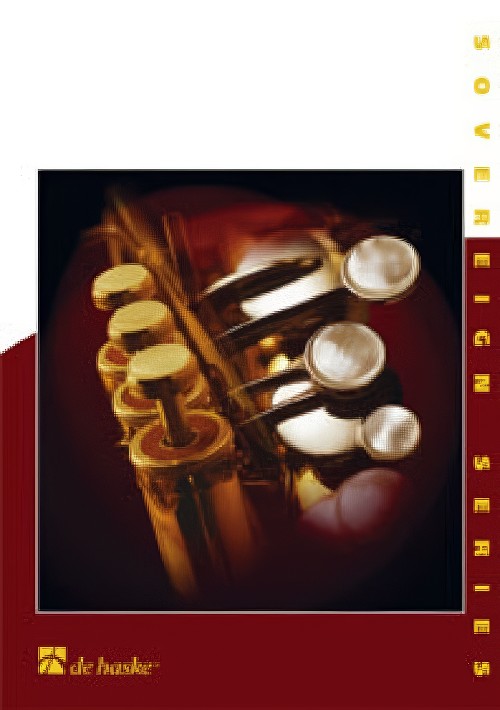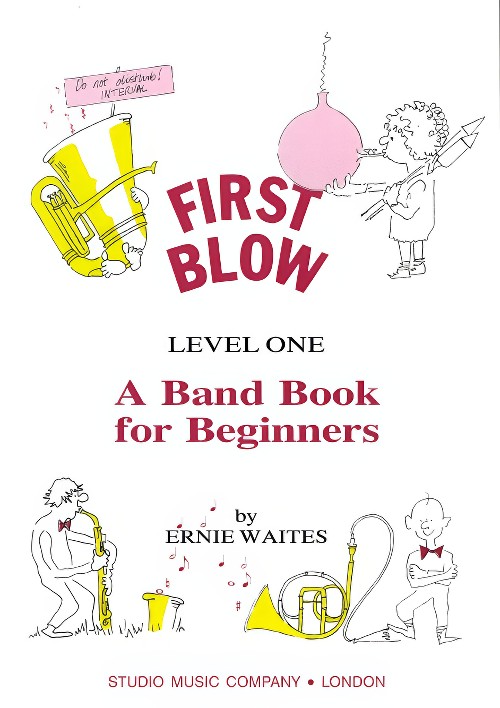Results
-
 £60.50
£60.50The Great Escape (Concert Band - Score and Parts) - Bernstein, Elmer - Smith, Robert W.
The Great Escape March is the title theme from the classic motion picture of the same name. In the style of a true concert march, the opening is bold and bombastic, with the following segments a blend and balance of melodies flowing throughout the woodwinds and brasses. The final statement is the sound of a troop of soldiers marching off into the distance. Captivating!Duration: 2.15
Estimated dispatch 7-14 working days
-
 £179.99
£179.99El Golpe Fatal (Concert Band - Score and Parts) - Brosse, Dirk
With the sound of trumpets and a long drum roll Dirk Bross takes you to the splendour of the opening ceremony of a bullfight! The rhythm and the use of South American percussion instruments convey a festive atmosphere whilst broad lines and bright colours describe the solemn nature of this event. The imaginary bull is received with great acclaim with the full band playing. Two contrasting themes represent the heroic matador and the condemned bull. The audience cheers as the bull collapses and strong final chords round off the triumph of the matador. The final quiet notes give a feeling of melancholy reflecting the sad end of this story.Duration: 13:45
Estimated dispatch 7-14 working days
-
 £89.95
£89.95First Blow - Level 1 (Value Set) - Waites, Ernie
The Value Set includes a score and 1 of each part.The aim of the book is to encourage group-playing in the early stages of learning. To this end, all the parts are deliberately simple and stick strictly to the four parts in the score. In addition there is percussion part (for which instruments should be chosen for each piece) and two learner parts (flute and trombone) for players who have learned only a handful of notes.Dynamics are not given - teachers should allow the players to try the pieces at different levels.The book is suitable for wind of brass bands (of a mixture of both!) and so far as possible, an equal number of players should be allocated to each part. If there is a lack of one of the parts, this part can be reinforced on piano, playing from the score.If clarinet players of a higher standard are available, they may prefer to play the 'upper octave' parts as this will brighten the overall sound of the band.Voices:Part 1 in C, Bb, Bb Upper Octave, EbPart 2 in Bb, Bb Upper Octave, Eb, FPart 3 in Bb, Bb Upper Octave, Eb, F, C BC, Bb BCPart 4 in Bb, Eb, C BC, Bb BC, Eb BCPercussionLerner FluteLerner TrombonePieces include:MarchPolkaShipsHymnCzardasStudy No.1NightfallStudy No.2CharlestonWaltzSlapstick
Estimated dispatch 7-14 working days
-
 £19.95
£19.95First Blow - Level 1 (Piano Conductor Score) - Waites, Ernie
The aim of the book is to encourage group-playing in the early stages of learning. To this end, all the parts are deliberately simple and stick strictly to the four parts in the score. In addition there is percussion part (for which instruments should be chosen for each piece) and two learner parts (flute and trombone) for players who have learned only a handful of notes.Dynamics are not given - teachers should allow the players to try the pieces at different levels.The book is suitable for wind of brass bands (of a mixture of both!) and so far as possible, an equal number of players should be allocated to each part. If there is a lack of one of the parts, this part can be reinforced on piano, playing from the score.If clarinet players of a higher standard are available, they may prefer to play the 'upper octave' parts as this will brighten the overall sound of the band.Voices:Part 1 in C, Bb, Bb Upper Octave, EbPart 2 in Bb, Bb Upper Octave, Eb, FPart 3 in Bb, Bb Upper Octave, Eb, F, C BC, Bb BCPart 4 in Bb, Eb, C BC, Bb BC, Eb BCPercussionLerner FluteLerner TrombonePieces include:MarchPolkaShipsHymnCzardasStudy No.1NightfallStudy No.2CharlestonWaltzSlapstick
Estimated dispatch 7-14 working days
-
 £84.99
£84.99Bread and Games Wind Band Set (Score & Parts)
Panem et Circenses', Bread and Games were essential for keeping the citizens of ancient Rome in check. While the bread was meant for the poorest among the Romans, the Games were Popular Pastime Number One for everybody.There were different kinds of games, such as chariot races (especially popular with female spectators), or wild-beast fights, where lions, tigers, bulls or bears were set on one another or even on human beings. Most popular, however, were the Gladiator fights. In 'Bread and Games' William Vean depicts one of the many fights in the antique Colosseum. 1. Entrance of the Gladiators: By powerful bugle-calls the attention of the people was asked for, after which the Gladiators entered the Arena at the sound of heroic marching-music.2.Swordfight: We can hear that the fights were not mere child's play in this part.On the contrary, they were a matter of life and death and were fought accordingly.3.Mercy of the Emperor: Sometimes a wounded gladiator could be fortunate, depending on the mercy of the audience. Waving one's handkerchief meant mercy, a turned-down thumb meant no pardon. The Emperor had the right to take the final decision, but he usually complied with the wish of the majority of the public. 4.Lap of Honour: Gladiators were mainly selected among slaves, convicted criminals, or prisoners of war. Consequently, winning was very important, as it would mean fame, honour and sometimes even wealth. A lap of honour, therefore, was the winner's due reward. 06:00
Estimated dispatch 7-14 working days
-
 £64.35
£64.35Ring the Bells on Christmas Day
This medley of three traditional Christmas carols is based on the legend that "at midnight the evening Jesus was born all the bells on earth started to sound of their own accord." Included are three "bell" carols, "The Bells of Bethlehem," "Carol of the Bells," and "Ding Dong! Merrily On High." The bells and chime parts add unique "authenticity" to the musical concept and holiday spirit of the piece. "Ring the Bells on Christmas Day" will be a big hit on your holiday season performances!
Estimated dispatch 7-14 working days
-
 £47.52
£47.52The Falling Rain
An absolutely stunning piece for young bands that is programmatic in design and hauntingly beautiful in every sense of the word. Your percussionists will enjoy the challenge of providing a myriad of colors to enhance this expressive work while audience members actively participate by creating the sound of falling rain. It should be noted that the technical demands of this composition are crafted so that the wind players will be able to focus on a highly expressive and musical performance. This latest offering by noted composer James Swearingen will make a superb addition to your band library. Very appealing!
Estimated dispatch 7-14 working days
-
 £154.99
£154.99Toyland Suite Wind Band Set (Score & Parts)
Who has not played with toys as a child? While listening to this wonderful suite, your audience will regain their youthful memories by entering a world of fantasy and imagination with each movement representing a different toy. Dolls and Marionettes - the dolls are echoed in a cheerful tempo, and the marionettes in a waltz. The Doll House - slower and more cantabile. The Train - we hear the steam engine, the steam whistle and the buzz of a tour in the world of imagination. The Tin Soldier - we hear footsteps far off, coming closer, the rhythm of the drums, the energetic sound of the army. Dressed in uniforms and in straight lines, they march in a perfect rhythm. Make yourself feel young once again with this great work. 15:30
Estimated dispatch 7-14 working days
-
 £144.99
£144.99Serenata - Jan van der Roost
While composing Serenata, Jan Van der Roost didn't focus too much on virtuosity, acrobatics or spectacle. Instead, he wanted to let the solo instrument shine as a melodic and expressive voice. And indeed: the warm sound of the euphonium touches the heart of the audience straight away in the first section with a melodious theme. Then follows a rigaudon, a noble and elegant dance from the Renaissance era. Despite the fact that some of the variations on the main theme require some technique and agility, the overall character mostly remains songful. The composition as a whole builds further on these two musical ingredients, but thanks to a clever alternation of melodic and technical passages, it offers a nice stylistic diversity to the listeners. The band is definitely not 'just accompanying' but fully participates and begins a dialogue with the soloist: both musical partners have their say. The end is more spectacular and sonorous, giving an extra boost of energy to the soloist as well as the band in a grand finale!
Estimated dispatch 7-14 working days
-
£56.50
Old St. Nicholas Had A Farm - Larry Clark
Imagine if you can the north pole where Santa keeps all of his reindeer. Someone, whether Santa himself or the elves in his employ, has to keep them fed, warm, and happy if they are to do the impossible again in a year's time. Old St. Nicholas Had a Farm has some fun with this idea by mashing up the classic song Old MacDonald with popular Christmas Carols. Using only the first six notes of the Bb scale and only two repeated eighth notes as the most challenging rhythm, students will feel comfortable playing the sound of sleigh bells, the crack of Santa's whip, and the thunder of reindeer hoofs. This piece will make a perfect addition to your next holiday concert and audienceswill delight in participating.
Estimated dispatch 7-14 working days
